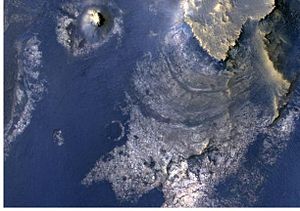

 | |
| Planet | Mars |
|---|---|
| Region | Oxia Palus quadrangle |
| Coordinates | 21°54′N 337°38′E / 21.9°N 337.63°E / 21.9; 337.63[1] |
| Quadrangle | Oxia Palus |
| Diameter | 90.92 km (56.50 mi)[1] |
| Depth | 2.2 km (1.4 mi)[2] |
| Eponym | Dean B. McLaughlin, American astronomer (1901-1965). (IAU, 1973).[1] |
McLaughlin Crater is an old crater in the Oxia Palus quadrangle of Mars, located at 21°54′N 337°38′E / 21.9°N 337.63°E / 21.9; 337.63. It is 90.92 km (56.50 mi)[1] in diameter and 2.2 km (1.4 mi)[2] deep. The crater was named after Dean B. McLaughlin, an American astronomer (1901-1965).[1][3] The Mars Reconnaissance Orbiter has found evidence that the water came from beneath the surface between 3.7 billion and 4 billion years ago and remained long enough to make carbonate-related clay minerals found in layers.[2][4] McLaughlin Crater, one of the deepest craters on Mars, contains Mg-Fe clays and carbonates that probably formed in a groundwater-fed alkaline lake. This type of lake could have had a massive biosphere of microscopic organisms.[5]

This article about the planet Mars or its moons is a stub. You can help Wikipedia by expanding it. |
This article about an extraterrestrial geological feature is a stub. You can help Wikipedia by expanding it. |